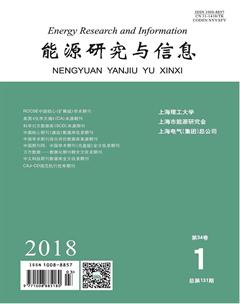遗传算法在水平轴洋流机叶片优化设计中的应用
余万 李春 杨阳



摘 要: 水平轴洋流机是捕获洋流能的主要设备,其叶片外形直接影响捕能效率。通过Bezier参数化曲线描述定速定桨距洋流机的叶片弦长和扭角分布规律,采用叶素动量理论计算其水动特性。以额定流速下能量利用系数系数最大为目标,基于遗传算法建立了叶片外形优化模型。同时,为了避免因汽蚀导致功率输出不稳定的现象,在优化过程中以汽蚀作为约束条件,与经典设计方法Wilson理论设计叶片进行了比较。结果表明:优化叶片在叶根处的扭角更小,具有更佳的抗扭性能;叶根和叶尖处弦长均更小,节省了材料;在设计流速范围内,优化叶片在低流速下效率更高,平均提高了4.6%,具有更好的启动性能。
关键词: 洋流机; 叶片; 汽蚀; 遗传算法; 优化
中图分类号: TK 83 文献标志码: A
Application of Genetic Algorithm to the Optimization
Design of Horizontal Axis Tidal Turbine Blade
YU Wan, LI Chun, YANG Yang
(School of Energy and Power Engineering/Shanghai Key Laboratory of Multiphase Flow and Heat Transfer
in Power Engineering, University of Shanghai for Science and Technology, Shanghai 200093, China)
Abstract: Horizontal axis tidal turbine is the key equipment to capture energy of the current.The blade shape can directly affect the capture efficiency.In this paper,the distribution of chord length and twist angle for tidal turbine blade with fixed speed and pitch was described by Bezier parametric curves.Bladeelement momentum theory was applied to calculate its hydraulic dynamic characteristics.With the goal of maximizing the power coefficient at the constant flow velocity,the optimization model of blade shape was built based on genetic algorithm.Meanwhile,in order to avoid the instability of power output caused by cavitation,the cavitation resistance was used as constraints in the optimization model.Compared with the classical Wilson theory of blade design,the results showed that the torsional angle has reduced in the hub of the optimized blade and the better torsion properties was achieved.The root and tip chord length of the blade decreased,which could save materials.Within the range of designed flow rate,higher efficiency was achieved for the optimized blade under low flow rate.The efficiency increased by 4.6% on average.The better startup performance was achieved as well.
Keywords: tidal turbine; blade; cavitation; genetic algorithm; optimization
在全球氣候变暖的背景下,随着能源短缺和经济高速发展,可再生能源发电技术更需进一步的飞跃,不仅要求处理温室效应而且要求保护自然环境以及与自然环境和谐共存。世界各国可持续发展的主要方向转向开发和利用绿色可再生能源。潮流能作为一种对环境几乎不会产生污染的可再生能源,蕴藏量丰富,而且具备相对成熟的利用技术,开发潜力极为巨大[1-2]。
叶片的性能直接影响着洋流机的性能,也是洋流机捕获洋流能的唯一部件,其制造成本也占整个发电机组的百分之二十左右[2]。叶片设计是洋流能利用效率的优劣和洋流机运行安全以及发电机组成本控制的关键因素。目前在国内外洋流机叶片设计大多数是采用了风力机的叶片设计方法[3],其中最为常用方法是与相关的约束模型结合的叶素动量理论,如Wilson模型[4-5]和Glauert模型[6]。其中,Wilson在Glauert研究的基础上考虑了升阻比和叶尖损失的影响提出的以单叶素截面输出最大功率为设计目标的叶片设计方法应用最为广泛[8-9]。该设计方法速度快,仅考虑了单个叶素的气动性能而忽略了叶素之间的相互影响。
洋流机工作环境和水泵相似,因此需要考虑洋流机叶片的汽蚀问题。汽蚀现象是在流体流动过程中,当某一局部区域的压力不大于水温相对应的汽化压力时,流体就会在该局部区域发生汽化[9-10]。汽化压力被定义为液体发生汽化时的压力,和液体种类、温度有关[11]。汽化产生的气泡顺流进入高压区发生破裂,引发周围液体高频碰撞从而导致材料受到破坏[12-13]。

